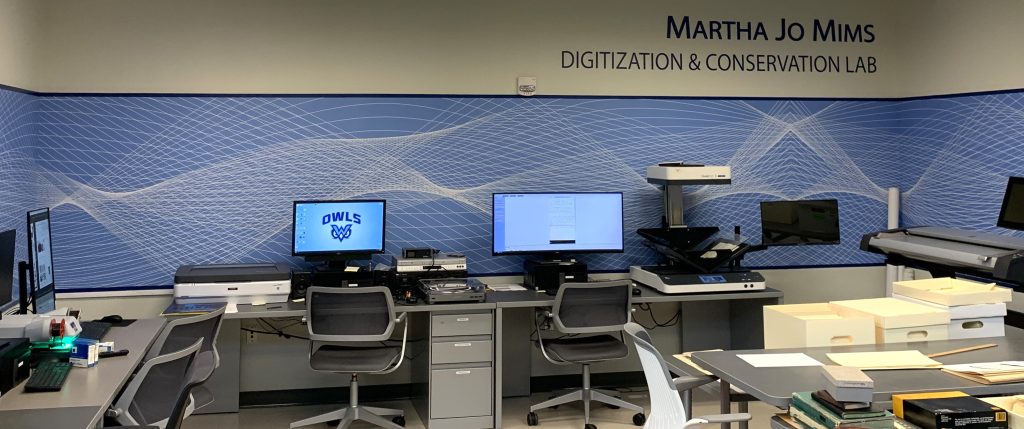Martha Jo Mims Digitization & Conservation Lab

About
The Martha Jo Mims Digitization & Conservation Lab conducts digital imaging and physical preservation of materials housed in the Beulah Culbertson Archives and Special Collections. It was created in 2019 by the generous gift of Laura and Ken Massey in honor of Laura’s instructor and mentor Dr. Mims. After retirement as an emeritus faculty, as a Volunteer Archives Specialist, Dr. Mims has and continues to provide invaluable expertise in identifying and categorizing archival materials.
Tours of the lab are available by request. Please contact the archives for details.
The Mims Digitization & Conservation Lab is also available as a facility for class or internship projects digitizing materials from the archives. Instructors or interns interested in using the lab can contact the archives for details.
Digitization
The Mims lab is currently equipped to digitize paper records; photographs; books and other bound items; newspapers, maps, and other oversize materials up to size A1; slides, negatives, and microfilm; compact cassettes (audio cassette tapes) and vinyl records; and VHS tapes. Materials are selected for digitization according to the amount of likely research use, historical value, fragility, condition, copyright/ownership status, and donor and faculty request.
Equipment
BookEye 4v2 600dpi color overhead book scanner: The BookEye scanner is used for flat, visual materials such as letters and photographs, and is also capable of scanning books without inverting them. It even has a 120-degree V-shaped glass plate, allowing us to scan books with tight or fragile bindings without completely opening them. This scanner uses BookEye’s OPUS FreeFlow digitization management software that handles imaging, image editing, metadata creation, and export in multiple formats.
Epson Expression 12000XL flatbed scanner: We use this scanner for flat, visual materials such as letters, photographs, and album covers. Currently we scan materials using Epson’s software and then manipulate images in Adobe Photoshop or Acrobat.
Canon imageFORMULA DR-6030C Production Scanner: The Canon scanner can scan up to 100 pages at a time through its document feeder, making it the ideal choice for scanning office documents in good condition.
Zoom F4 Multitrack Field Recorder: For recording audio materials we rely on the Zoom F4, into which we connect a Tascam 202MKVII Double Cassette Recorder Deck, Audio-Technica Belt Drive Stereo Turntable, or potentially many other vintage audio playback devices as we collect more vintage audio.
USB 2.0 Audio/Video Converter: This small device digitizes A/V material from any playback device with an RCA cable, such as VHS players.
HP HD Pro 2 42-in Scanner: This wide-format scanner is used for scanning oversized items. From architectural drawings to research posters, the built-in HP software allows staff to quickly and safely create scans of our large documents.
Capture Specs
| Format | Master File | Use Copies |
| Handwritten material | 600 ppi TIFF | 200 ppi JPEG |
| Office records | 300 ppi PDF/A | 150 ppi PDF |
| Photographs | 600 ppi TIFF | 200 ppi JPEG |
| Audio | WAV | MP3 |
| Video | AVI | MP4 |
Preservation
The Mims lab is also outfitted with equipment and supplies to conduct a number of preservation treatments for records in the Beulah Culbertson Archives and Special Collections. These practices include:
Humidification: An EX-LIBRIS humidification chamber is used to create a humid environment for rolled or curled materials, allowing them to be safely flattened and dried.
Encapsulation: Using rolls of .003 inch polyester film with double-sided tape and a Kutrimmer 1080 cutter, the archives can create sleeves. These can hold any flat material from small photographs to blueprints, maps, and newspapers, allowing them to be used safely without tearing or other damage.
Phase boxes and pamphlet bindings: The Kutrimmer and a corner rounder with sheets of acid-buffered corrugated cardboard and velcro coins are used to fashion bespoke boxes for books with fragile bindings or loose pages.